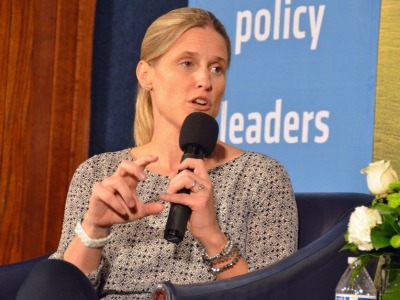With unemployment spiking across the country as a result of the coronavirus, more and more people who never needed food assistance before are looking for help, forcing food banks, commodity groups and USDA to think creatively about how to meet the growing demand.
Agriculture Secretary Sonny Perdue may announce as early this week how he plans to spend the $9.5 billion in the recent coronavirus stimulus bill relief to help struggling farmers, ranchers, the dairy industry and local food systems. He also has $6 billion in Commodity Credit Corporation funding to use until July, when the borrowing authority will be replenished to the tune of $14 billion.
Perdue has not made any public proclamations about how the money will be used, although he said at a recent press conference that the department had difficulty last year in finding a home for $50 million in milk purchases.
The issue, Perdue said, was a lack of cold storage at food banks for perishable items such as milk. Feeding America, an organization with 200 member food banks nationwide, expects to receive results a survey of its members this week on storage capacity and other issues.
Suggestions for how to spend the newly available money have come from many quarters of the industry, including from fruit and vegetable growers from California to Florida who are seeking $5 billion in assistance, and the dairy industry, which has laid out a plan asking the federal government to “use every financial tool in its arsenal to bring balance to the dairy industry as quickly as possible.”
Produce industry groups asked USDA to streamline its vendor approval process and "expeditiously facilitate fresh produce commodity purchases, separate from existing purchasing programs, for redistribution to food banks, schools, and other emergency feeding sites."
“We’re all full of advice right now,” says Dale Moore, executive vice president of the American Farm Bureau Federation and a longtime Washington hand, who expects Perdue to announce his intentions this week.
One idea floated by AFBF and Feeding America in a letter to Perdue is a program that would allow food banks to use vouchers to cover food purchasing and processing and distribution costs.
Moore said Tuesday he had “an encouraging phone call” with a USDA official about the program, though he cautioned that what USDA comes up with “may not look anything like we proposed.”
The key, Moore said, is for USDA to keep the process as simple as possible so struggling producers can efficiently deliver nutrition where it’s needed most.
Vouchers could be used to buy dairy and other foods and get them processed into consumer-friendly packaging, he said. They even could be used to rent cold storage.

Dale Moore, American Farm Bureau Federation
Food distribution is changing rapidly due to COVID, forcing Feeding America to keep going back to its network to gauge its capacity for both storage and distribution.
Carrie Calvert, FA’s vice president of government relations for food and agriculture, said her group’s survey “is meant to get an idea of the amount of food the food banks can accept.”
“Although shelf stable is easiest, they are still distributing perishable food,” Calvert said. “The key is to make sure the deliveries are more frequent and sized to fit the refrigeration and freezer capacity we have on hand, and to provide additional resources to increase that refrigeration and freezer capacity.”
Milk producers have been dumping product because of oversupply resulting from the drying up of traditional outlets such as food service and schools. Produce growers who have allowed vegetables to rot in their fields are in the same boat.
“This is such a unique circumstance that it really does require some unique thinking and some creative thinking,” says former Secretary of Agriculture Tom Vilsack, head of the U.S. Dairy Export Council and a board member at Feeding America. One possibility, he said, is for refrigerated tankers to pull up to food banks and distribute milk that way.
Alan Bjerga, senior vice president for communications at the National Milk Producers Federation, says “capacity solutions are being worked on in real-time so that food banks are equal to the challenges they are facing. Dairy farmers are ready to meet this demand.”

Carrie Calvert, Feeding America
For food banks with adequate cold storage, additional deliveries of milk are not a problem. One such operator in Florida is saying, in essence: bring it on.
Dave Krepcho, president and CEO of Second Harvest Food Bank of Central Florida, has 100,000 cubic feet of cold storage, but says the milk “moves very quickly so storage isn’t a major issue for us.”
He acknowledges that “you might get a different answer on storage from other food banks,” but at Second Harvest, which also has refrigerated trucks, “We can handle what’s coming our way.”
Krepcho says he’s also “getting a lot more food from Florida farmers — we’re trying to capture as much as we can here.” People love the fresh produce, he says.
Demand has nearly doubled at Second Harvest, Krepcho says, to the point where the food bank is providing enough food for 250,000 people a day. “It’s unreal,” he says.
In addition to recently enacted legislation, USDA can use existing purchasing authorities such as its Section 32 nutrition assistance program and a 2018 trade mitigation program to buy commodities.
Interested in more coverage and insights? Receive a free month of Agri-Pulse or Agri-Pulse West by clicking here.
Those purchases “can keep processors running and sustain supply chains farmers rely on to sell their milk,” Bjerga said. “They also send important demand signals to markets, which can raise dairy prices and, in the end, reduce the cost of assistance to the federal government.”
USDA’s Agricultural Marketing Service won’t discuss future purchases, but it has continued to solicit bids under those programs.
AMS said that on an ongoing basis, it collaborates with the department's Food and Nutrition Service to buy and distribute over $2 billion of U.S. agricultural products for schools, food banks, tribal organizations and other domestic and international food outlets.
“Trade mitigation and Section 32 purchases recently have increased annual spending to about $4 billion, with the majority of the extra product going to food banks,” the spokesperson said.
Moore said he sympathizes with Perdue and his team at USDA, who are working to flesh out the details of their aid package, which is eagerly anticipated by the agriculture industry. And in future, “Should there be a need for more resources. I feel confident we’re all going to be pulling on our oars together,” he said.
For more news, go to www.Agri-Pulse.com.


